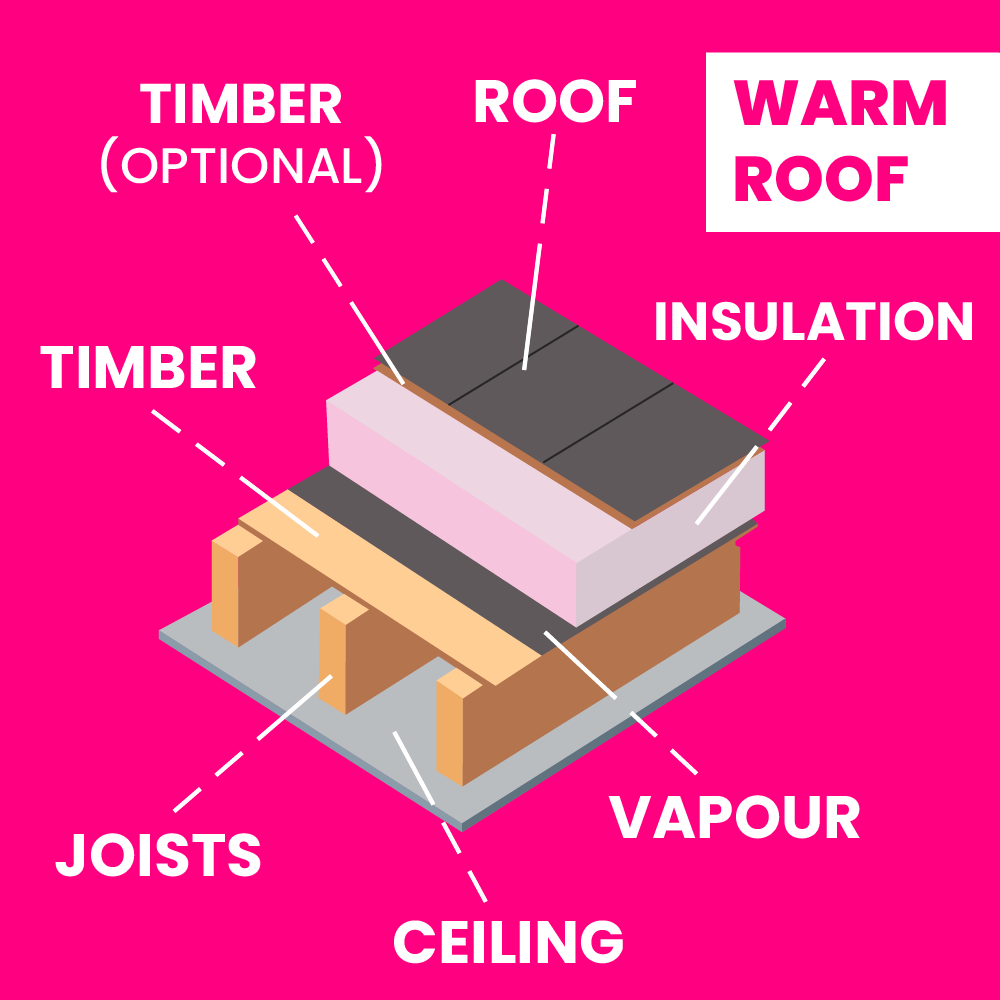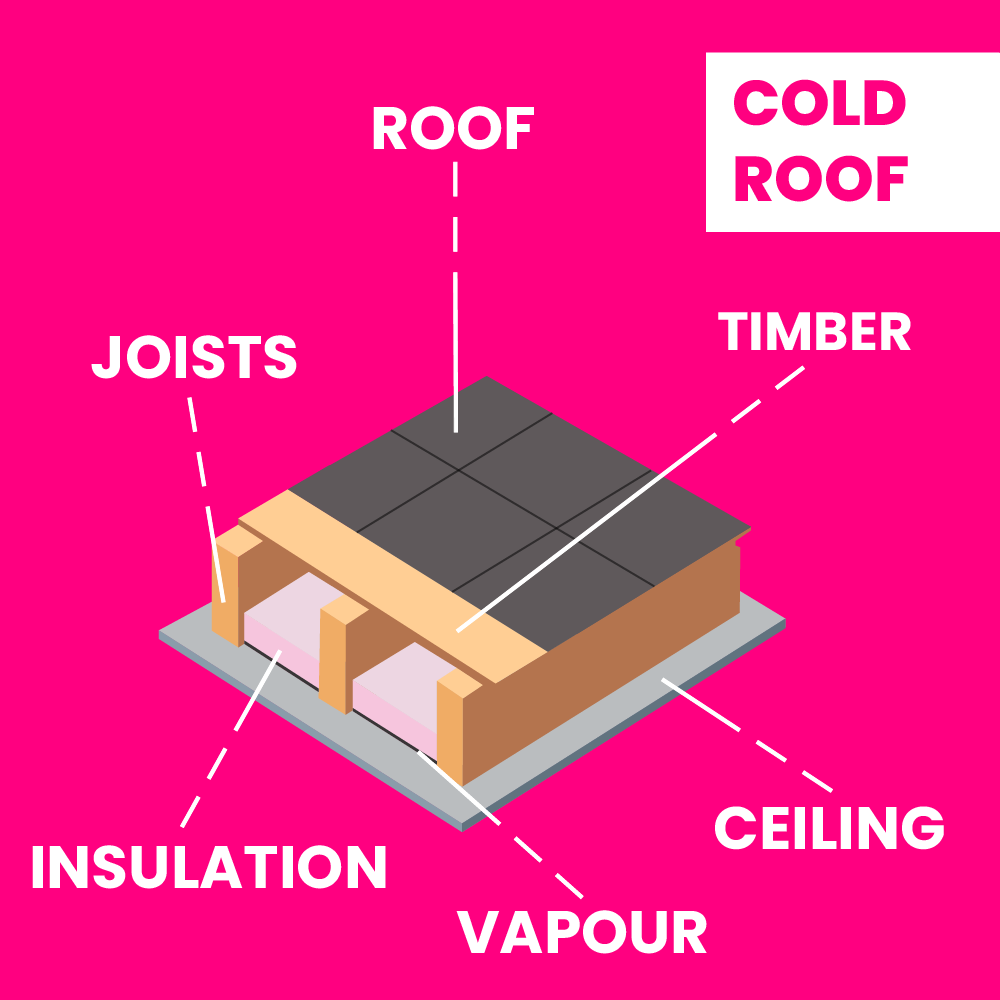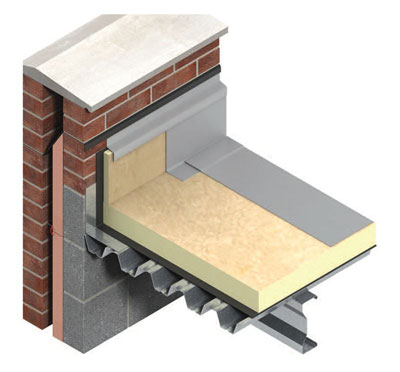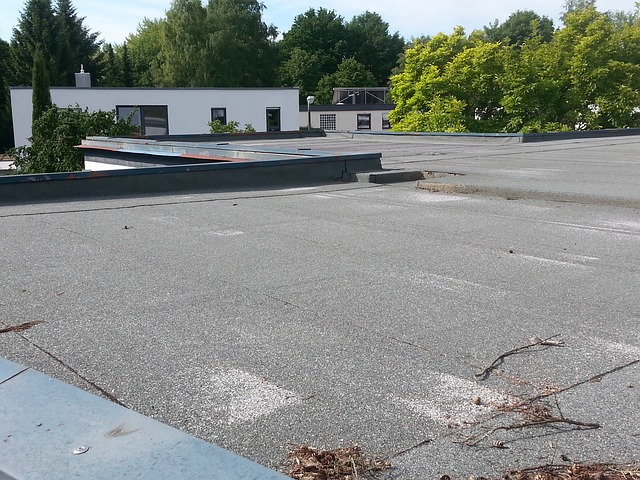Insulating a flat roof is a task that should be carried out during the construction phase. Retrofitting flat roof insulation is a difficult task and often a messy one that involves pulling up the waterproof layer that finishes off the deck to put flat roof insulation in underneath.
What’s more, you won’t be able to pass your building or extension through required regulations without flat roof insulation, so installation is vital. Therefore, as we mentioned, insulating a flat roof in the first instance is the best way to achieve a well-insulated, competent and good-looking structure.
With this in mind, we’ve got an information-packed help and advice guide right here to help you understand more about insulating a flat roof.
Table of contents:
- What is a warm or cold roof?
- How do you insulate a flat roof?
- What flat roof insulation should I use?
- Final thoughts
What are warm roof deck and cold roof deck constructions?
A warm flat roof deck construction is the most common and most preferred type of flat roof build-up in the UK. The flat roof insulation is located above the joists and below the waterproof membrane in this instance.

A cold flat roof deck construction, on the other hand, is where the insulation is placed between the joists. However, ventilation is required for this type of roof deck solution, so it’s important to bear this in mind before you install this system.

How do you insulate a flat roof?
Insulating a flat roof is relatively simple in terms of what materials you need, and the steps taken to complete the job.
Let’s take a closer look.
Step 1: Install plywood or OSB board
Lay 12mm of plywood or OSB board across the timber joists as a base for the flat roof build-up. This provides a sturdy foundation for the rest of the roof structure.
Step 2: Fit the vapour control layer
Install a vapour control layer to reduce the risk of condensation and moisture compromising the flat roof structure. This layer helps maintain the integrity of the roof over time.
Step 3: Mark for fixings
Mark out on the vapour control layer where fixings will pierce the membrane, ensuring they align at rafter centres and at the correct axial spacing.
Step 4: Apply butyl tape
Place butyl tape at each point where the vapour control layer will be pierced. This creates a seal after penetration, preventing moisture infiltration and enhancing the roof’s longevity.
Step 5: Place the rigid insulation board
Lay rigid insulation board to the desired thickness, often dictated by available height due to guttering, upstands, and other features. Proper insulation improves energy efficiency and structural integrity.
Step 6: Add a second layer of plywood or OSB board
Install a second layer of plywood or OSB board to reinforce the roof structure. This additional layer enhances durability and load-bearing capacity.
Step 7: Fix the deck together
Fix the deck together with helical fixings, piercing each layer of the buildup including the flat roof insulation. This securely fastens all components, minimising the risk of displacement.
Step 8: Install the waterproof membrane
Finally, install a waterproof membrane to finish off the deck and protect the build-up from wind and driven rain. This membrane serves as the outermost layer, safeguarding the roof against water damage and weathering.
What flat roof insulation should I use?
Using insulation board in a flat roofing insulation build-up is a widely accepted industry standard as it’s one of the best weight-bearing insulation types. Whether the flat roof being installed will be walked on or not, flat roof insulation board typically has a hard-faced surface and good compressive strength both for extra stability and extra adhesion for the waterproof membrane.
Kingspan and Recticel are two of the most well-known flat roof insulation brands and they’re firm favourites of Insulation Superstore customers.
With that in mind, let’s have a closer look at how to insulate a flat roof with each one of these two options.
Insulating a flat roof with Recticel Powerdeck U
Recticel’s Powerdeck U offers a 0.024 U-value for thicknesses 120mm or more so it’s a great thermal insulator as well as a strong and stable board for structural integrity. Powerdeck U can be used with hot-applied waterproof membranes like torch-on felt and mastic asphalt thanks to a bitumen glass fleece facing. Its moisture-resistant properties also make it an attractive selection for installing a warm flat roof as the material won’t degrade if it gets slightly damp, allowing the insulation board to maintain its thermal properties and continue to insulate the flat roof.

Insulating a flat roof with Kingspan Thermaroof
Kingspan has two somewhat similar flat roofing insulation products that come highly recommended by contractors and roofers alike. Kingspan Thermaroof TR26 and Kingspan Thermaroof TR27 are both high-performance PIR boards which are both approved for steel flat roof deck assemblies.
Thermaroof TR26 is designed for use with a mechanically fixed single-ply waterproofing membrane thanks to foil facings on both sides. It achieves a u-value of 0.022 and can be used in conjunction with green roof systems.
Thermaroof TR27 has glass tissue facings on either side of the flat roof insulation board which allow the product to offer u-values as low as 0.024. Excellent compressive strength and the coated glass tissue facings combine to make Thermaroof TR27 compatible with mechanically fixed single-ply waterproofing membranes and partially bonded built-up felt.
Final thoughts

Insulating a flat roof significantly improves energy efficiency by reducing heat loss in colder months and minimising heat gain in warmer seasons, leading to lower heating and cooling costs.
What’s more, insulation helps maintain a consistent indoor temperature, enhancing comfort levels year-round. By preventing condensation and moisture buildup, insulation also helps protect the roof structure from damage, prolonging its lifespan.
Overall, insulating a flat roof not only enhances comfort and structural integrity but also promotes environmental sustainability by reducing energy consumption and carbon emissions.
Flat roof insulation projects can be undertaken by capable DIYers looking to top out a garden building or small extension, but it can be quite tricky.
Bottom line:
Flat roof insulation can easily create leaks, moisture and damp if not done properly, so you must get it right the first time.
Not sure how to insulate a pitched roof? Our guide for insulating a roof can help you out! Go ahead and check it out for help with your project.


















